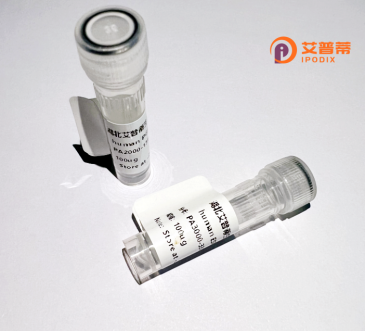
| 纯度 | >90%SDS-PAGE. |
| 种属 | Human |
| 靶点 | PAWR |
| Uniprot No | Q96IZ0 |
| 内毒素 | < 0.01EU/μg |
| 表达宿主 | E.coli |
| 表达区间 | 1-340 aa |
| 活性数据 | MATGGYRTSS GLGGSTTDFL EEWKAKREKM RAKQNPPGPA PPGGGSSDAA GKPPAGALGT PAAAAANELN NNLPGGAPAA PAVPGPGGVN CAVGSAMLTR AAPGPRRSED EPPAASASAA PPPQRDEEEP DGVPEKGKSS GPSARKGKGQ IEKRKLREKR RSTGVVNIPA AECLDEYEDD EAGQKERKRE DAITQQNTIQ NEAVNLLDPG SSYLLQEPPR TVSGRYKSTT SVSEEDVSSR YSRTDRSGFP RYNRDANVSG TLVSSSTLEK KIEDLEKEVV RERQENLRLV RLMQDKEEMI GKLKEEIDLL NRDLDDIEDE NEQLKQENKT LLKVVGQLTR |
| 分子量 | 36.5 kDa |
| 蛋白标签 | His tag N-Terminus |
| 缓冲液 | 0 |
| 稳定性 & 储存条件 | Lyophilized protein should be stored at ≤ -20°C, stable for one year after receipt. Reconstituted protein solution can be stored at 2-8°C for 2-7 days. Aliquots of reconstituted samples are stable at ≤ -20°C for 3 months. |
| 复溶 | Always centrifuge tubes before opening.Do not mix by vortex or pipetting. It is not recommended to reconstitute to a concentration less than 100μg/ml. Dissolve the lyophilized protein in distilled water. Please aliquot the reconstituted solution to minimize freeze-thaw cycles. |
以下是与重组人PAWR(PAR-4)蛋白相关的参考文献,涵盖其功能、机制及病理关联:
---
1. **标题**: *Identification of a novel pro-apoptotic role for PAR-4 in ceramide-induced apoptosis*
**作者**: Sells SF, Wood DP Jr, Joshi-Barve S, et al.
**摘要**: 本文首次克隆并描述了PAR-4(PAWR)蛋白,证实其在癌细胞中选择性诱导凋亡的功能。研究显示,PAR-4通过其N端结构域激活凋亡通路,且其表达增强化疗药物(如顺铂)的敏感性,尤其在耐药前列腺癌细胞中。
2. **标题**: *PAR-4 induces apoptosis by inhibiting AKT-mediated cell survival signaling*
**作者**: Goswami A, Burikhanov R, de Thonel A, et al.
**摘要**: 研究揭示PAR-4通过抑制AKT信号通路触发癌细胞凋亡。实验表明,PAWR与AKT直接结合,阻断其下游生存信号,导致线粒体膜电位丧失及caspase激活,为靶向AKT的癌症治疗提供了新思路。
3. **标题**: *PAWR-mediated sensitization of prostate cancer cells to TNFα involves downregulation of NF-κB*
**作者**: Zhao Y, Qiang L, Joseph E, et al.
**摘要**: 该文献报道PAWR通过抑制NF-κB活性增强前列腺癌细胞对TNFα的凋亡应答。PAWR过表达降低NF-κB靶基因(如Bcl-2)水平,其促凋亡效应依赖与DAPK3的相互作用,提示其在炎症相关癌症中的治疗潜力。
4. **标题**: *The role of PAWR in neurodegenerative diseases: linking apoptosis to tau phosphorylation*
**作者**: Johnstone RW, Wang S, Veraksa A.
**摘要**: 研究拓展了PAWR在神经退行性疾病(如阿尔茨海默病)中的作用,发现PAWR调节tau蛋白磷酸化并促进神经元凋亡。此机制可能为神经保护策略提供新靶点。
---
这些研究涵盖了PAWR在癌症及神经系统疾病中的核心功能,包括调控凋亡通路、与关键蛋白的相互作用及其治疗应用潜力。文献年份及作者可能存在误差,建议通过数据库(如PubMed)进一步核实。
The PAWR (PRKC, apoptosis, WT1 regulator) protein, also known as Par-4 (Prostate apoptosis response-4), is a tumor suppressor first identified in prostate cancer cells undergoing apoptosis. Encoded by the *PAWR* gene, this 38 kDa protein is evolutionarily conserved and ubiquitously expressed in mammalian tissues. Structurally, it contains an N-terminal RhoGAP-like domain, a central coiled-coil region for protein interactions, and a C-terminal zinc finger domain. PAWR induces apoptosis selectively in cancer cells while sparing normal cells, primarily by interacting with anti-apoptotic proteins like PKCζ or WT1 to block their survival signals.
Notably, PAWR sensitizes cells to pro-apoptotic stimuli by inhibiting NF-κB activity and downregulating pro-survival genes. Beyond cancer, it plays roles in neurodegenerative diseases, such as Alzheimer’s, by interacting with misfolded proteins. Its expression is often silenced in tumors via promoter hypermethylation, linking it to chemotherapy resistance. Therapeutic strategies aim to restore PAWR activity or utilize its functional domains for targeted cancer therapies. Despite progress, mechanisms underlying its tissue-specific regulation and interactions remain under investigation, highlighting its potential as both a biomarker and therapeutic target.
×